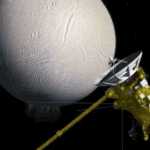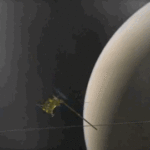A Whiff of That Ocean Spray, Very Far Away
Just a few minutes ago, at 11:22 a.m. Eastern time, NASA’s Cassini spacecraft flew just 30 miles above the surface of Saturn’s moon Enceladus. This pass over the southern polar region shot the probe through a plume of water vapor and ice spray erupting from the ocean below the moon’s surface.
As it continues its pass, Cassini is taking a big whiff of the spray to get samples for the onboard ion and neutral mass spectrometer and cosmic dust analyzer instruments. These are testing for molecular hydrogen and heavier molecules necessary for life, whose presence would help characterize what’s going on in the liquid ocean below the frozen surface. NASA scientists have said hydrothermal activity at the global ocean’s floor is expelling water through seafloor vents that is at least 194 degrees Fahrenheit. These conditions, along with complex molecular building blocks, mean that extraterrestrial microbial life, at least, is a real possibility in Enceladus’s waters.
“Confirmation of molecular hydrogen in the plume would be an independent line of evidence that hydrothermal activity is taking place in the Enceladus ocean, on the seafloor,” said Hunter Waite, the instrument team leader at Southwest Research Institute. “The amount of hydrogen would reveal how much hydrothermal activity is going on.”


